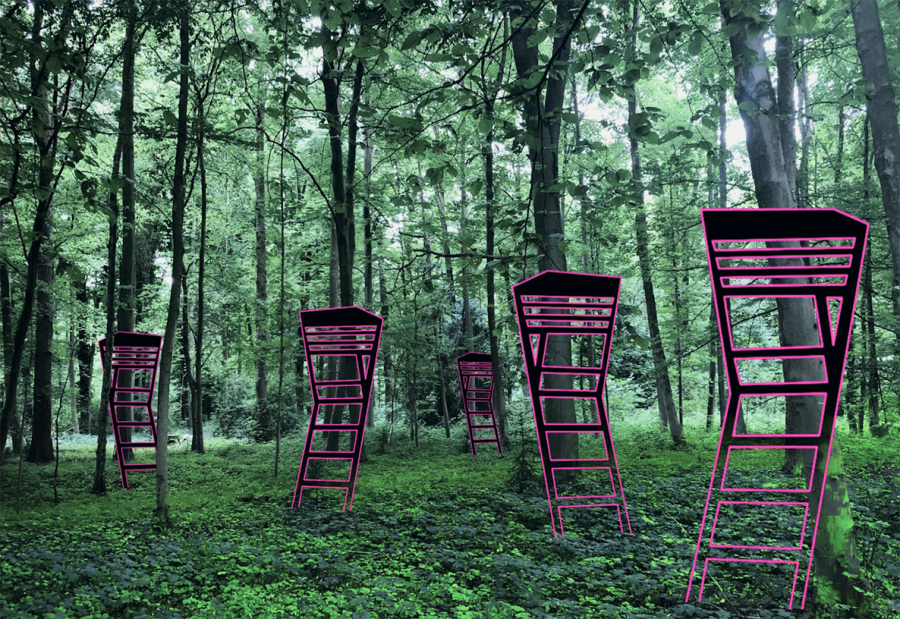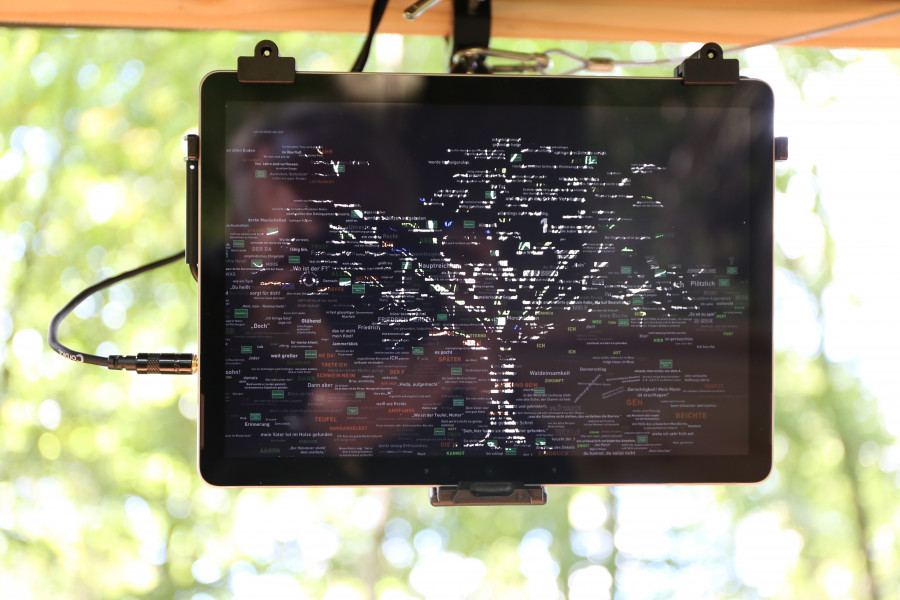Exhibition in the park of Burg Hülshoff.
Duration: 16.6.2023 - 13.8.2023
Friday to Sunday 11am–5pm
**Duration: approx. 2 hours
Price per person 5 €
With the ticket, the installation can be visited all day.
When Die Judenbuche by Annette von Droste-Hülshoff was first published in 1842, it was in a magazine in 16 parts with the subtitle Ein Sittengemälde aus dem gebirgichten Westfalen. Today the text is a classic of world literature and for many a must in school lessons. In the park of Burg Hülshoff in Westphalia, Die Judenbuche is now the starting point for an installation by Rimini Protokoll. A mixture of radio play, film and contemplation of nature has been created on eight trees.
Helgard Haug and Daniel Wetzel from the well-known directing and theatre collective Rimini Protokoll went out to talk to people about their experiences with this text but especially with the themes of this text: about domestic violence, addictions, precarious living, classism, anti-Semitism, corruption and bent law. They were also interested in the mechanisms of a community, as so described by Droste-Hülshoff on the basis of »Village B«:
» Recht und Unrecht sind einigermaßen in Verwirrung geraten. Neben dem gesetzlichen hat sich ein zweites Recht gebildet: Ein Recht der öffentlichen Meinung, der Gewohnheit und der Verjährung. Es lässt sich behaupten: die Form ist schwächer, der Kern fester, die Vergehen häufiger, Gewissenlosigkeit seltener.«
— from »Die Judenbuche« by Annette von Droste-Hülshoff
The subjects are so present that Helgard Haug and Daniel Wetzel decided on an unusual manoeuvre: Whereas in their many years of staging they often overwrite original texts and replace protagonists with experts from today's everyday culture, for this work they turn to the original text a second time. They make small but decisive surgical interventions in the original.
How does the text sound in the present tense? How does it sound when it is told from different perspectives at the same time? What happens when the characters in the story become voices and appropriate the Droste text as a subjective? What happens when the visitors assign roles to each other? How does their perception of the text change when they take a seat on one of the eight high seats set up in the woods behind the castle to experience the 16 Scenes for a Forest from there?

»Where otherwise a hunter sits as still as possible to observe and act, voices and sounds now resound and instructions are played to the visitors, making them not only recipients of the updated text but also participants in the play, who together may succeed in chasing the ghosts of the past out of this little forest,« say Helgard Haug and Daniel Wetzel about their production of Judenbuche.
However, Haug and Wetzel have taken one thing away from the text for their adaptation: anti-Semitism. Its mechanism of dissemination is clearly evident in Droste-Hülshoff's text, its cruelty is structural and present in Droste's work, even before the deed is committed: the murder of the Jew Aaron. The author's work is based on a historically documented case, but it is not only the »Dorf B« that is already Droste-Hülshoff's model of a village, a meta-village. The characters - the F, the J, the von S - are also prototypes, as is the silent majority of the villagers. The Jews of the area appear as that entity in the narrative who behave coherently and without contradictions according to their grief. Nevertheless, the text's attitude to the anti-Semitism described is unclear and is partly masked by the fact that it is open to needs for a transcendental instance.
Haug and Wetzel open Droste's text to a completely different experience: In the here and now of a forest, can a group of people write themselves into the text?

With the voices of: Gerd Brendel, Heiko Daniels, Bettina Grahs, Vassilis Koukalani, Lorenz Krieger, Jacques Malan, Mia Rainprechter, Hilmar Wittler, and others
Concept, text editing, sound: Helgard Haug and Daniel Wetzel
Video: Marc Jungreithmeier
Sound Mix: Frank Böhle
Technical management: Patrick Tucholski
Assistance: Lisa Homburger
Collaboration audio editing: Steffen Tielcke
Technical equipment, forest work: Klaudiusz Schimanowski
Head of production CfL: Sophie Stroux
Production management RP: Vera Nau
Oriental music: Aspa Anogiati (Lyra, Bendir, Musical advice and arrangement), Badee Alhindi (Violin, Rebab, Cello) Ahmad Almir (Oud), Özlem Yilmaz (Ney)
With the use of Nisiotikos Chorus (Traditional), To Minore Tis Avis (Traditional), Franz Schubert: Gute Nacht.
Thanks to the Mannheim, Pia Goebel, Anja Heizer, the Nationaltheater Mannheim, Dominika Siroka.
Förderer







16 Szenen für einen Wald ist eine Koproduktion von Burg Hülshoff – Center for Literature mit Rimini Apparat, gefördert durch die Kunststiftung NRW, das Ministerium für Kultur und Wissenschaft des Landes Nordrhein-Westfalen und das Landesbüro Freie Darstellende Künste.
Die Installation ist Teil des Projekts Mit den Gespenstern leben (haunting|heritage), das gefördert wird durch die Kulturstiftung des Bundes, die Beauftragte der Bundesregierung für Kultur und Medien, das Ministerium für Kultur und Wissenschaft des Landes Nordrhein-Westfalen im Programm »Regionales Kultur Programm NRW«, die Commerzbank-Stiftung und die Kunststiftung NRW.
Partner


Präsentiert von Kultur.West und taz. die Tageszeitung.
